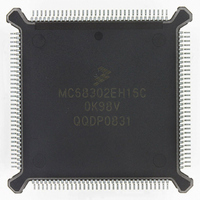MC68302EH16C Freescale Semiconductor, MC68302EH16C Datasheet - Page 335

MC68302EH16C
Manufacturer Part Number
MC68302EH16C
Description
IC MPU MULTI-PROTOCOL 132-PQFP
Manufacturer
Freescale Semiconductor
Datasheets
1.MC68302AG20C.pdf
(4 pages)
2.MC68302AG20C.pdf
(2 pages)
3.MC68302AG20C.pdf
(13 pages)
4.MC68302EH16C.pdf
(481 pages)
Specifications of MC68302EH16C
Processor Type
M683xx 32-Bit
Speed
16MHz
Voltage
5V
Mounting Type
Surface Mount
Package / Case
132-MQFP, 132-PQFP
Controller Family/series
68K
Core Size
32 Bit
Ram Memory Size
1152Byte
Cpu Speed
16MHz
No. Of Timers
3
Embedded Interface Type
SCP, TDM
Digital Ic Case Style
PQFP
Rohs Compliant
Yes
Family Name
M68000
Device Core
ColdFire
Device Core Size
32b
Frequency (max)
16MHz
Instruction Set Architecture
RISC
Supply Voltage 1 (typ)
5V
Operating Temp Range
0C to 70C
Operating Temperature Classification
Commercial
Mounting
Surface Mount
Pin Count
132
Package Type
PQFP
Lead Free Status / RoHS Status
Lead free / RoHS Compliant
Features
-
Lead Free Status / Rohs Status
RoHS Compliant part
Electrostatic Device
Available stocks
Company
Part Number
Manufacturer
Quantity
Price
Company:
Part Number:
MC68302EH16C
Manufacturer:
Freescale Semiconductor
Quantity:
135
Company:
Part Number:
MC68302EH16C
Manufacturer:
PANA
Quantity:
99
Company:
Part Number:
MC68302EH16C
Manufacturer:
Freescale Semiconductor
Quantity:
10 000
Part Number:
MC68302EH16C
Manufacturer:
FREESCALE
Quantity:
20 000
Company:
Part Number:
MC68302EH16CB1
Manufacturer:
Freescale Semiconductor
Quantity:
10 000
Company:
Part Number:
MC68302EH16CR2
Manufacturer:
Freescale Semiconductor
Quantity:
10 000
- MC68302AG20C PDF datasheet
- MC68302AG20C PDF datasheet #2
- MC68302AG20C PDF datasheet #3
- MC68302EH16C PDF datasheet #4
- Current page: 335 of 481
- Download datasheet (2Mb)
APPENDIX A
SCC PERFORMANCE
The MC68302 at 16.67 MHz was originally designed to support unrestricted operation of
multiple (three) serial communications controllers (SCCs) servicing differing communica-
tions protocols with cost-effective usage of silicon at data rates of 256 kbps for HDLC-
framed or transparent data handling and 128 kbps for BISYNC, DDCMP, V.110, or asyn-
chronous framed data. The resultant design has exceeded these design goals.
Since the MC68302 serial channels will likely service serial channels time-division multi-
plexed into higher bandwidth channels, such as the U.S. and Japanese T1 and European
CEPT primary rate channels, the physical clocking of the serial channels can be accom-
plished at the higher speeds required by these channels—up to a maximum of 40% (a 1:2.5
ratio) of the system clock frequency. This gives up to a 6.67-MHz serial clock for a 16.67-
MHz IMP system clock. At this same 16.67-MHz system clock speed, the MC68302 can
therefore handle the 1.544-MHz and 2.048-MHz clocking frequencies of T1 and CEPT lines
as well as the 4.096-Mbps signaling rates of the common ISDN interchip local buses, such
as IDL and GCI (also known as IOM-2).
Thus, the MC68302 is well equipped to handle, for instance, three 256-kbps channels mul-
tiplexed on a T1 or CEPT primary rate channel.
Where an application requires even higher bandwidth channels, such as the 384-kbps H0
channels, the 1.536-Mbps H11 channel, or higher, the following restriction should be ob-
served: bus latency of the SDMA must be less than 20 system clocks. (The BCLR signal
may be helpful here.)
If the above restriction is adhered to, the following table shows experimental performance
data obtained with the device.
The frequency ratio stated represents the system (EXTAL) frequency to serial bit rate fre-
quency. A user exceeding this bit rate will begin to experience SCC underruns and/or over-
runs. Some users may wish to tolerate an occasional underrun/overrun to slightly increase
performance.
16.67 MHz can support an MC68302 serial rate of 1.67 Mbps. Typically, this 1.67-Mbps rate
would be achieved with 1 bit every 1.67-MHz serial clock. However, it may also be achieved
MOTOROLA
For example, a ratio of 1:10 in the following table shows that an MC68302 system clock of
A previous revision of this manual showed two additional restric-
tions which have now been eliminated.
MC68302 USER’S MANUAL
NOTE
A-1
Related parts for MC68302EH16C
Image
Part Number
Description
Manufacturer
Datasheet
Request
R
Part Number:
Description:
Manufacturer:
Freescale Semiconductor, Inc
Datasheet:

Part Number:
Description:
MC68302 Configuring the Chip Selects on the MC68302
Manufacturer:
Motorola / Freescale Semiconductor

Part Number:
Description:
MC68302 Design Concept - Expanding Interrupts on the MC68302
Manufacturer:
Motorola / Freescale Semiconductor

Part Number:
Description:
MC68302 MC68302 Adapting a WAN Controller to a LAN Environment
Manufacturer:
Motorola / Freescale Semiconductor

Part Number:
Description:
MC68302 EKB Applications - Power Measurements on the MC68302
Manufacturer:
Motorola / Freescale Semiconductor

Part Number:
Description:
MC68302 Interfacing the MC68020 to a Slave MC68302
Manufacturer:
Motorola / Freescale Semiconductor

Part Number:
Description:
MC68302 MC68302 Software Performance
Manufacturer:
Motorola / Freescale Semiconductor

Part Number:
Description:
MC68302 Evaluating EDX on the ADS302
Manufacturer:
Motorola / Freescale Semiconductor

Part Number:
Description:
MC68302 Design Advisory #1 - MC68SC302 Passive ISDN Protocol Engine
Manufacturer:
Motorola / Freescale Semiconductor

Part Number:
Description:
MC68302, MC68360, and MPC860 Characteristics and Design Notes for Crystal Feedback Oscillators
Manufacturer:
Motorola / Freescale Semiconductor
Part Number:
Description:
Mc68302 Integrated Multi-protocol Processor
Manufacturer:
Freescale Semiconductor, Inc
Datasheet:
Part Number:
Description:
Manufacturer:
Freescale Semiconductor, Inc
Datasheet:
Part Number:
Description:
Manufacturer:
Freescale Semiconductor, Inc
Datasheet:
Part Number:
Description:
Manufacturer:
Freescale Semiconductor, Inc
Datasheet:
Part Number:
Description:
Manufacturer:
Freescale Semiconductor, Inc
Datasheet:











